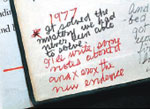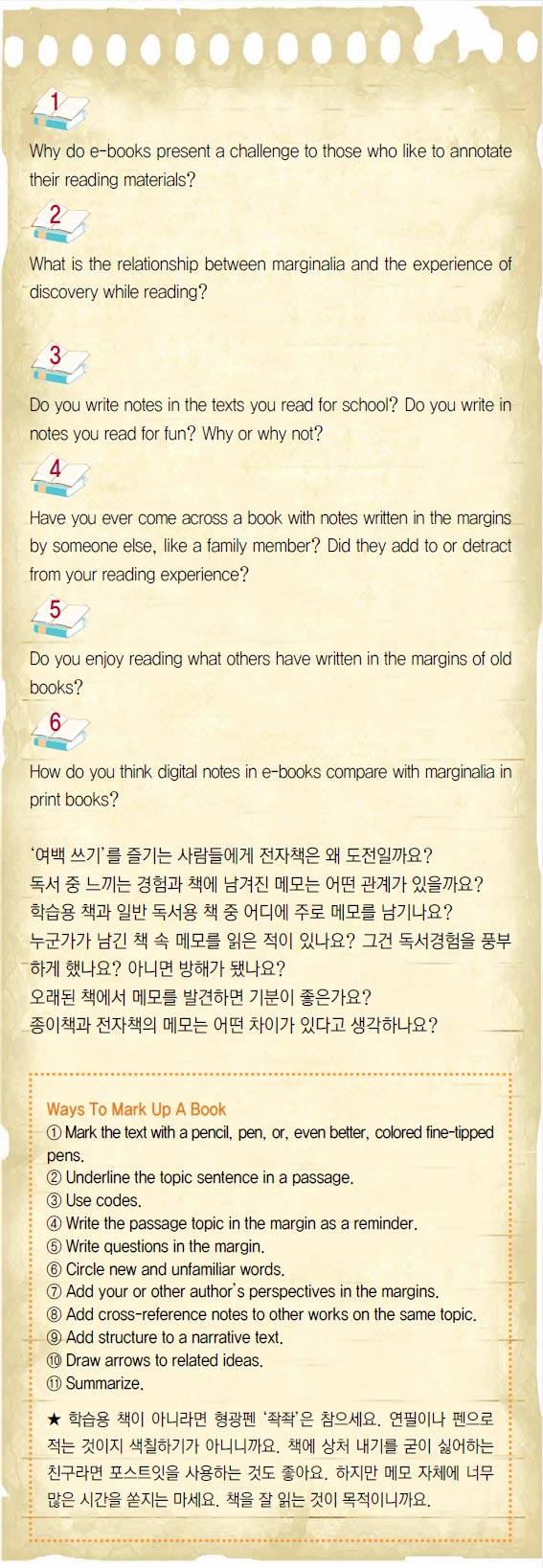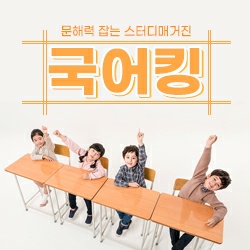![[신나는 nie/뉴욕타임스와 함께]What I Really Want Is Someone Rolling Aro](./www/data/news/201103/20110325-n2a.jpg)
《‘책을 제대로 읽으려면 메모하면서 보라’는 말을 들은 적이 있는데요. 느낌도 적고 줄도 그으며 저자의 생각에 공감도 하고 반박도 하고…. 적극적으로 읽으면 그 만큼 얻는 게 많겠지요. 하지만 이런 생각도 들어요. “책이란 게 읽고 싶을 때 편하게 펼치는 것이지, 번거롭게 언제 필기구를 챙겨?” 그런데 이 글을 쓴 아저씨는 필기구 없이는 책을 읽지 않는다고 하네요.
<정리 & 구성=이수경 기자 ysk@donga.com > 》
 |
| A collection of books with notations by well-known writers includes one scribbled in by Ben Hecht. |
This hit home for me ― it spoke to the little scribal monk who lives deep in the scriptorium of my soul ― and I quickly adopted the habit of marginalia: underlining memorable lines, writing keywords in blank spaces, jotting important page numbers inside of back covers. It was addictive, and useful. It quickly began to feel, for me, like something more intense: a way to not just passively read but to fully enter a text, to collaborate with it, to mingle with an author on some kind of primary textual plane.
Soon my little habit progressed into a full-on dependency. My markings grew more elaborate ― I made stars, circles, checks, brackets, parentheses, boxes, dots and lines (straight, curved and jagged). I noted intra- and extratextual references; I measured cadences with stress marks. Texts that really grabbed me got full-blown essays (sideways, upside-down, diagonal) in the margins.
대학 도서관에서 읽을 만한 책을 찾던 중 발견한 한 마디가 내 독서 인생을 바꿔놓았어요. “당신이 책에 표시하지 않는 한 그 책은 진정 당신의 소유가 아니다.”
그 말에 감동받아 여백에 글 쓰는 습관을 들였죠. 기억에 남을 만한 말에 밑줄 긋기, 빈 공간에 키워드 적기, 중요한 페이지 번호를 표지 뒷면에 적기…. 그건 유용했고 중독성이 있었죠. 좋은 문장을 찾아 ‘위대한 유산’으로 만드는 걸 즐겼다. 책에 ‘마킹’하는 건 특별한 게 아니라 알고 보니 ‘7가지 효과적 대학 공부법’ 중 하나더군요. 수동적으로 읽는 게 아니라 내가 책 속으로 들어가 저자와 ‘텍스트 비행기’를 타고 함께 어울리는 듯한 강렬한 느낌이랄까요.
내 마킹 습관은 갈수록 정교해졌죠. 별, 동그라미, 체크, 괄호, 박스, 점뿐만 아니라 직선, 곡선, 들쭉날쭉한 선, 각주 달기, 강세 표시…. 옆으로 거꾸로 대각선으로 적힌 메모는 때로 한편의 글이 되기도 하죠. 그러다 보니 내가 아주 좋아하는 책들은 기본적으로 ‘파괴’됐죠.
이제 손에 필기구 없이는 읽지를 않아요. 책은 나의 일기장이며 중요한 공책이며 창작 밑그림인 데다 일상적인 명상이죠. ‘여백에 쓰기’는 과장 없이 매일의 일상 중 가장 즐거운 일이랍니다.
Today I rarely read anything ― book, magazine, newspaper ― without a writing instrument in hand. Books have become my journals, my critical notebooks, my creative outlets. Writing in them is the closest I come to regular meditation; marginalia is ― no exaggeration ― possibly the most pleasurable thing I do on a daily basis.
All of which means I’ve been feeling antsy over the last five years, as I’ve watched the inexorable rise of e-readers.
I sympathize with the recent wave of public teeth-gnashing about the future of marginal notes. The digital book ― scentless, pulp-free, antiseptic ― seems like a poor home for the humid lushness of old-fashioned marginalia. You can’t even write by hand in an e-book ― at least not comfortably, not yet. As John Dickerson recently put it on Slate, describing his attempt to annotate books on an iPad: “It’s like eating candy through a wrapper.” Although I’ve played with Kindles and iPads and Nooks, and I like them all in theory, I haven’t been able to commit to any of them. As readers, they disable the thing that, to me, defines reading itself. And yet I’ve continued to hope that, in some not-too-distant future, e-reading will learn to take marginalia seriously. And it looks as if that might be happening right now.
Because this yearning for social reading persists. I recently let a friend borrow my copy of David Foster Wallace’s “Infinite Jest,” one of the more compulsively annotated books in my library. Midway through her reading, I needed it back, so she switched to a virginal store-bought copy. The fresh one, she told me afterward, felt a little lonely by comparison: she missed the meta-conversation running in the margins, the sense of another consciousness co-filtering D.F.W.’s words, the footnotes to the footnotes to the footnotes to the footnotes.
What I really want is someone rolling around in the text. I want noticing. I want, in short, marginalia, everywhere, all the time.
최근 5년 새 온라인 독자가 늘어나는 것을 보면서 한편으로 안타깝고 걱정도 돼요. 냄새와 종이가 없어진 디지털북은 ‘여백 쓰기’를 못하니 가난한 집 같아요. 물론 쓸 수는 있지만 최소한 편하지는 않잖아요. 아이패드로 주석 달기를 해 본 사람은 사탕을 포장지에 싼 채로 먹는 것 같다고 하더군요. 나도 아이패드를 즐겨 사용하지만 ‘마킹’은 하지 않아요. 하루빨리 전자책이 ‘여백 쓰는 법’을 진지하게 배우길 바랍니다.얼마 전 친구에게 ‘여백 쓰기’가 많이 된 아끼는 책을 빌려주었어요. 도중에 필요해서 돌려받고 그 친구는 새 책을 읽어야 했죠. 내 책을 읽으며 소통하는 느낌이었던 것에 비해 새 책을 읽으며 외로움을 느꼈다네요. 그래서 나는 사람들이 책 속 여백에서 함께 거닐었으면 좋겠어요.
「사진으로나마 마크 트웨인의 필체가 담긴 책을 보니 신기하네요. ‘허클베리핀’의 작가가 오래 전 어느 날 이 책을 읽었구나 싶어서요.
저도 책에 메모를 별로 안 하는 편인데요. 문득 이런 생각이 듭니다. 낡은 책에 서 나의 부모님이 남긴 오래된 메모를 발견하면 어떤 기분일까? 또 나의 아이들, 멀리는 손자 손녀가 나의 메모를 뒤늦게 찾으면 또 어떤 느낌일까?
내가 재미있게 읽은, 드문드문 메모가 곁들여진 책을 친구에게 권해보는 건 어떨까요? 친구랑 책 속에서 ‘특별한 산책’을 할 수 있겠네요.」
 |
위 기사의 법적인 책임과 권한은 어린이동아에 있습니다.
< 저작권자 ⓒ 어린이동아, 무단 전재 및 재배포 금지 >

 프린트
프린트


 공유하기
공유하기

 페이스북
페이스북 트위터
트위터 카카오스토리
카카오스토리 네이버밴드
네이버밴드









※ 상업적인 댓글 및 도배성 댓글, 욕설이나 비방하는 댓글을 올릴 경우 임의 삭제 조치됩니다.
더보기